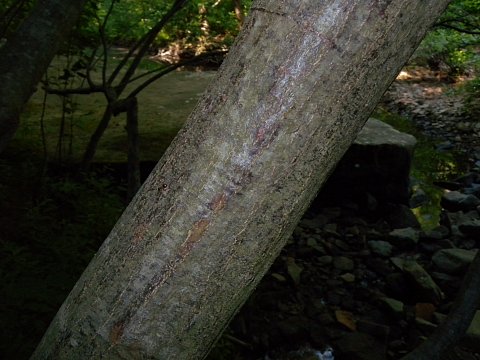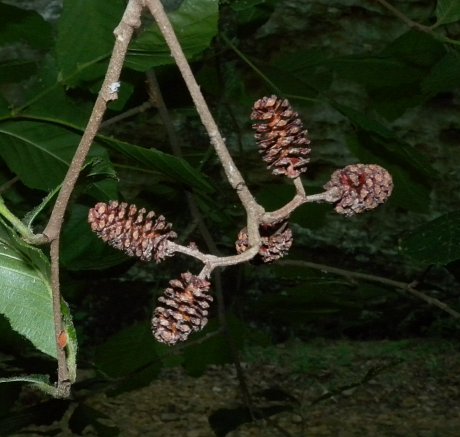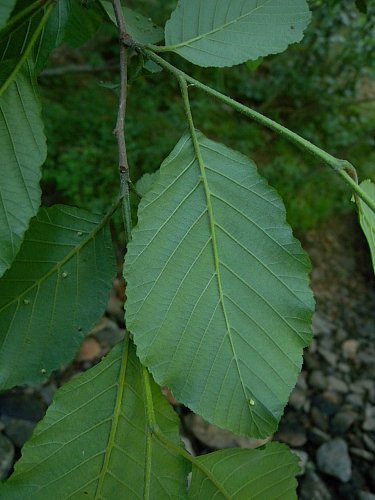
This shrub is monoecious, producing male (staminate) and female (pistillate) flowers on separate catkins. Immature catkins are present during the fall and persist through the winter in a dormant state. During the blooming period, drooping male catkins occur in clusters of 2-5 near the tips of the branches. The male catkins are 2-4" long, narrowly cylindrical in shape, and brownish yellow. Each flower male consists of a lobed calyx and stamens (about 4), but lacks petals. Several male flowers are grouped together behind each floral scale of the male catkin. The female catkins occur in clusters of 2-5 at the tips of twigs, where they are usually more or less erect. During the blooming period, each female catkin is about ¼" long and either red or purple. Each female flower consists of a naked ovary with a pair of styles; it has neither petals nor a significant calyx. A few female flowers are grouped together behind each floral scale of the female catkin. The blooming period occurs during early to mid-spring before the vernal leaves develop. The catkins are cross-pollinated by the wind. Afterwards, the female catkins become cone-like fruits about ½-¾" long, and their scales become dark brown and woody. At the base of each scale, there is a single nutlet about 2-3 mm. long that is flattened-obovoid in shape and narrowly winged. The nutlets are distributed to some extent by either wind or water. The woody root system is spreading and shallow.

Cultivation: The preference is partial sun or light shade, wet to moist conditions, and an acidic soil that is rocky, gravelly, or sandy. The root system fixes nitrogen in the soil and it reduces erosion along streambanks.
Range & Habitat: The native Brookside Alder occurs in southern Illinois, where it is occasional, while elsewhere in the state it is absent (see Distribution Map). Illinois lies along the NW range limit of this species. Habitats include rocky streambanks at the bottom of sandstone ravines and canyons, swamps, fens, and edges of lakes. This alder has a more southern distribution than other native alders (Alnus spp.) within the state.

Faunal Associations: Insects that feed on Brookside Alder include a flea beetle (Altica ambiens), a leaf beetle (Baliosus nervosus), a plant bug (Ceratocapsus pumilus), two leafhoppers (Erythridula rugosae, Kybos unica), Lintner's Scurfy Scale (Chionaspis lintneri), larvae of a gall fly (Dasineura serrulatae), and leaf-mining larvae of a moth (Phyllonorycter auronitens); see Clark et al. (2004), Eiseman (2016), Wheeler et al. (1983), Dmitriev & Dietrich (accessed 2010), ScaleNet (accessed 2014), Aldrich & Osten-Sacken (1905), and Needham et al. (1928) for more information. Other insects that are known to feed on alders include larvae of wood-boring beetles, larvae of sawflies, larvae of many moths, aphids, and lace bugs. Among vertebrate animals, several species of birds feed on the seeds or buds of alders, including ducks, songbirds, and game birds (see Bird Table). Many birds also use these shrubs/trees for protective cover and nesting habitat; this includes the Rose-breasted Grosbeak, Song Sparrow, Fox Sparrow, Red-winged Blackbird, Rusty Blackbird, Wilson's Warbler, Yellow Warbler, Alder Flycatcher, Willow Flycatcher, and American Woodcock (the latter bird sometimes nests on the ground in Alder thickets); see DeGraaf (2002). The American Beaver feeds on the bark and wood of alders, and it uses the small trunks and branches in the construction of its dams and lodges. White-tailed Deer browse on the twigs, while the Woodland Jumping Mouse feeds on the seeds (Martin et al., 1951/1961; Hamilton, 1941).

Photographic Location: Along a rocky streambank at the bottom of a sandstone canyon in southern Illinois.
Comments: In addition to Brookside Alder, other common names of this shrub (Alnus serrulatus) include Common Alder, Smooth Alder, and Hazel Alder. This is the only native alder that is found in southern Illinois, making it relatively easy to identify. In northern Illinois, the similar Alnus incana (Speckled Alder) can be found. This latter shrub differs from Brookside Alder by the conspicuous white lenticels on its trunks, the whitened undersides of its leaves, and doubly serrated margins of its leaves. A European species that is sometimes cultivated and escapes, Alnus glutinosus (Black Alder), is a substantially larger tree. It has leaves that are more orbicular in shape and its leaves usually have fewer pairs of lateral veins (7 or less).